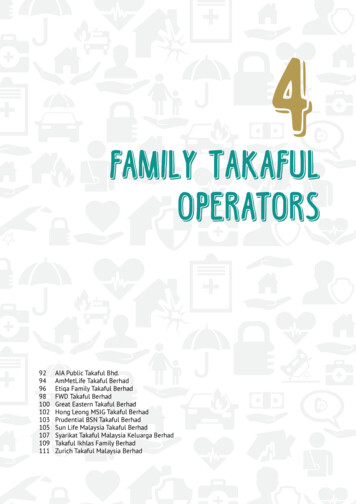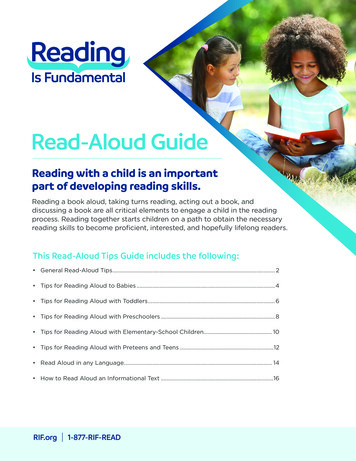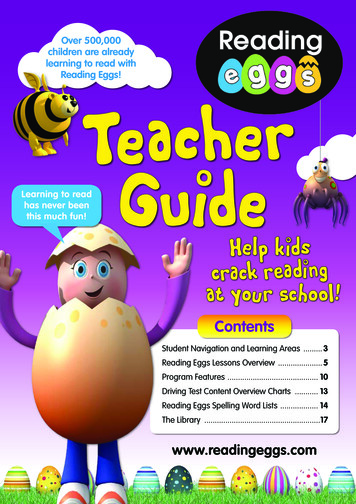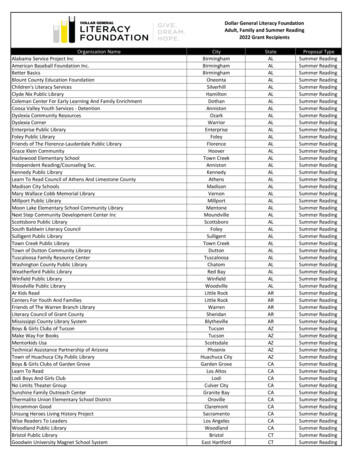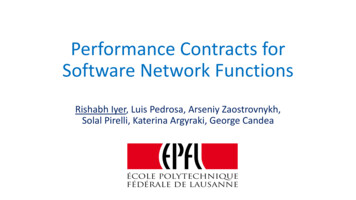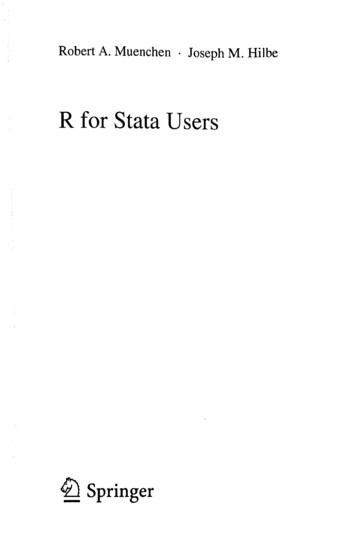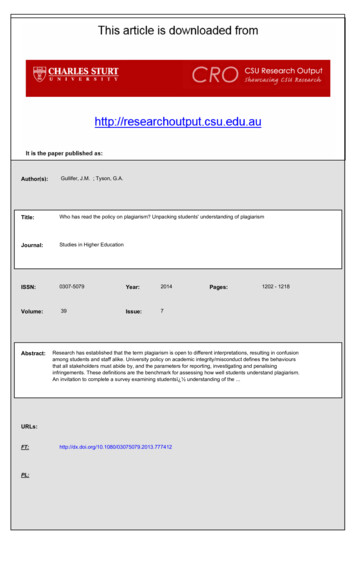
Transcription
Author(s):Gullifer, J.M. ; Tyson, G.A.Title:Who has read the policy on plagiarism? Unpacking students' understanding of plagiarismJournal:Studies in Higher stract:PL:1202 - 1218Research has established that the term plagiarism is open to different interpretations, resulting in confusionamong students and staff alike. University policy on academic integrity/misconduct defines the behavioursthat all stakeholders must abide by, and the parameters for reporting, investigating and penalisinginfringements. These definitions are the benchmark for assessing how well students understand plagiarism.An invitation to complete a survey examining students� understanding of the 2013.777412
Reading the policy on plagiarism 1Running head: Reading the policy on plagiarismWho has read the policy on plagiarism? Unpacking students‟ understanding ofplagiarism
Reading the policy on plagiarism 2AbstractResearch has established that the term plagiarism is open to differentinterpretations, resulting in confusion among students and staff alike.University policy on academic integrity/misconduct defines the behavioursthat that all stakeholders must abide by, and the parameters for reporting,investigating and penalising infringements. These definitions are thebenchmark for assessing how well students understand plagiarism. Aninvitation to complete a survey examining students‟ understanding of theinstitutional policy on academic integrity was sent to all domestic studentsenrolled at an Australian University. A total of 3405 students completed thesurvey. The data were examined by year of study, Faculty, and whether thestudents were studying on-campus or by distance education. Findings indicatethat only half of the participants had read the policy on plagiarism and thatconfusion regarding what behaviours constitutes plagiarism was evident. Theimplications of these findings are that systematic educative approach ofacademic integrity is warranted.Key wordsAcademic Integrity, College students, Education Higher, Plagiarism, UniversityPolicy, Universities (education), University Student
Reading the policy on plagiarism 3Who has read the policy on plagiarism? Unpacking students‟ understanding of plagiarismIn Higher Education, mastery of competent and disciplinary-specific writing isarguably a fundamental skill that demonstrates a student‟s understanding of subject-basedknowledge (Berkenkotter & Huckin, 1995). Students express their authorial voice bysynthesising the ideas drawn from scholarly literature within their own work. This processrequires understanding the rationale for attribution and how to cite original sources in orderto avoid plagiarism (Wingate, 2006). Yet the evidence suggests that many studentsunintentionally plagiarise, and confuse plagiarism with behaviours that are defined ascheating or collusion (Ashworth, Bannister, & Thorne, 1997; Barrett & Cox, 2005; Gullifer& Tyson, 2010). Moreover, not understanding what plagiarism is appears to contribute toincreased anxiety of inadvertent plagiarism and uncertainty of what constitutes plagiarism(Ashworth et al., 1997; Breen & Maassen, 2005; Gullifer & Tyson, 2010; James, McInnis, &Devlin, 2002; Yeo, 2007). Studies indicate that plagiarism may occur due to this confusionrather than intentional plagiarism (Ellery, 2008; Gullifer & Tyson, 2010; Park, 2003;Sutherland-Smith, 2008; Zimitat, 2008). Specifically, students may not realise that alteringan original source, even by a few words constitutes plagiarism and that internet sources mustbe cited.The confusion surrounding the term plagiarism may also be experienced byacademics, therefore contributing to the inconsistencies students are exposed to. For examplein two studies conducted by Miguel Roig (1997, 2001) students and academics were able toparaphrase simple text without plagiarising, but as text became more complex and technical,many students (Roig, 1997) and some academics (Roig, 2001) made minor changes to thetext by altering a few words. Although greater skill is required to paraphrase dense and
Reading the policy on plagiarism 4complex text, this practice could be construed as plagiarism due to the lack of attribution.Similarly in the high school setting, Craig and Evans (1990) found that a quarter of teachersand almost half of the students did not realise paraphrased text must be acknowledged.These findings reinforce the idea that there is no absolute standard among staff inrecognising plagiarism, and therefore managing it consistently.After examining the plethora of research published on academic dishonesty/misconduct/integrity, it is obvious that a standard definition does not exist. Some studiesgroup all academic misconduct behaviours as a single category, or other studies will use avariety of terms to define academic dishonesty, with plagiarism often described as being aform of cheating, academic fraud, misrepresentation or fabrication (Ashworth et al., 1997;Athanasou & Olasehinde, 2002; McCabe, 1992; McCabe, 2005b; McCabe, Trevino, &Butterfield, 2001, 2002; Newstead, Franklyn-Stokes, & Armstead, 1996; Whitley Jr, 1998).It is therefore hardly surprising that the ambiguous nature of the term plagiarism may resultin inadvertent plagiarism.Chris Park (2003) confirmed that students are genuinely perplexed about the conceptof plagiarism. He found that some students unintentionally plagiarise due to the lack offamiliarity with writing conventions when quoting and paraphrasing. There is also anexpectation that students entering university understand the values of authorship, thereforethe importance of attribution. They are also expected to discern common knowledge frommaterial that must be cited. The uncertainty surrounding plagiarism is further complicated bycontextual issues, such as the perceived degree of seriousness and degrees of violations.While there appears to be little agreement on a precise definition of plagiarism, there isconsensus that it includes using another person‟s ideas, work, and expression and passing itoff as one‟s own ideas, work and expression (Gibaldi, 2003).
Reading the policy on plagiarism 5Arguably the definitions that determine what constitutes plagiarism are those withinuniversity policy. It is these definitions that all stakeholders in the university setting mustabide by, and that set the parameters for reporting, investigating and penalisinginfringements. More importantly, it is these definitions that should be the benchmark forassessing how well students understand plagiarism. By delimitating definitions of plagiarismto those set in university policy, the problem of generalising and finding a universaldefinition is eliminated. This is an important consideration given the socio-cultural context inwhich plagiarism occurs.It is of interest to note that a search of the published literature revealed that whileresearch has investigated why students‟ plagiarise (Burrus, McGoldrick, & Schuhmann,2007; McCabe, 2005b; Sutherland-Smith, 2005); who plagiarises,(Harding, Mayhew, Finelli,& Carpenter, 2007; Iyer & Eastman, 2006; McCabe, 2005a); how they plagiarise (McCabe& Trevino, 1993); how many plagiarise (Hard, Conway, & Moran, 2006; Lin & Wen, 2007;McCabe, 2005b) what students think it is (Ashworth, Freewood, & Macdonald, 2003; Devlin& Gray, 2007; Gullifer & Tyson, 2010; Power, 2009; Yeo, 2007) and how to prevent it(Devlin, 2006; Duggan, 2006; McGowan, 2005a) no research to date has actually askedstudents if they had read the institutions policy, or how well they understand the definitionsof the different academic misconduct behaviours within that policy. Given the importance ofuniversity policy to strategically guide the management of plagiarism and the emphasisplaced on communicating the policy to all stakeholders, this anomaly is interesting.Moreover the consequence of not reading the policy may contribute to widespread ignoranceof what behaviours constitute plagiarism.A case-study approach, therefore, was initiated to investigate how well students‟ atan Australian university understand plagiarism, as defined in that institution‟s Academic
Reading the policy on plagiarism 6Misconduct Policy. Charles Sturt University (CSU) is a multi-campus university with fourfaculties (Arts, Business, Education and Science) offering a diverse range of courses anddisciplines at the Bachelor and postgraduate level. The majority of students at CSU study bydistance-education (off- campus). Distance education utilises teaching methods andtechnology to enable students to access education when they are not physically present oncampus (Cleveland-Innes & Garrison, 2010). Studying by distance education requires accessto the internet as courses are supported by online technology.The Charles Sturt University policy on Academic Misconduct (2010) subsumesplagiarism (along with collusion and cheating) as one of three types of academic misconduct.Within the policy, academic misconduct is defined as:. acting in a way, or attempting to act in a way, or assisting another student to actin a way which could reasonably be expected to defeat the purpose of a learningexperience or an item of assessment or an examination. Academic misconduct willnormally be evidenced by plagiarism, cheating or collusion (p.2).The Academic Misconduct Policy defines plagiarism as occurring when;. he or she [student] gives the impression that the ideas, words or work of anotherperson are the ideas, words or work of the student. Plagiarism will include:copying any material from books, journals, study notes or tapes, the Web, the workof other students, or any other source without indicating this by quotation marks orby indentation, italics or spacing and without acknowledging that source byfootnote or citation;orrephrasing ideas from books, journals, study notes or tapes, the Web, the work ofother students, or any other source without acknowledging the source of thoseideas by footnotes or citations. This could include material copied from a sourceand acknowledged, but presented as the student’s own paraphrasing. (p. 2)The Academic Misconduct Policy at CSU recognises that consideration of the motivation ofthe student is important when assessing cases of plagiarism as can be seen in the followingextract:
Reading the policy on plagiarism 7Plagiarism is to be distinguished from inadequate and/or inappropriate attempts toacknowledge the words, works or ideas of someone else, as for example when astudent makes a genuine attempt to reference their work, but has very poorreferencing skills. (p.2)While the policy recognises that cases may differ according to the intent of thestudent, a booklet developed by the university advises students that academics areresponsible for reporting suspected cases of plagiarism to the appropriate authorityregardless of intent (McVilly & McGowan, 2007) . Moreover, students are also informed inthe booklet that factors such as the „the seriousness of the misconduct, the relativeexperience of the student and whether the student has previously been found guilty ofmisconduct‟ (p.8) are considered when an allegation of plagiarism is investigated. Penaltiesare stated to become “progressively harsher depending on the nature of the plagiarism” (p.8).Penalties can range from no action to be taken, a caution or reprimand, resubmit work, nomarks awarded for submitted work, fail subject, and exclusion from university. Acombination of these penalties can also be applied.Currently at CSU, the responsibility to learn about academic integrity resides with thestudent. The CSU student charter (Charles Sturt University, 2012) suggests that theuniversity encourages a sense of community and with that comes shared values andexpectations. The shared values refer to freedom of inquiry, knowledge refinement anddissemination, ethical practice, and the responsible stewardship of resources. These valuesare expressed through shared expectations that staff and students have of each other. Thepoints in the charter relevant to academic integrity are that students can expect:access to information about University regulations, policies and proceduresincluding research and study requirements, and that they will be appliedappropriatelyAnd the university can expect students to:
Reading the policy on plagiarism 8adhere to University rules, regulations, policies and proceduresinteract with the University with honesty, integrity and in a timely mannerAccording to the charter, the role of the university is to make access to theinformation about university regulations, policies and procedure available, with theassumption that once the information is available, it is the responsibility of the student to befamiliar with, and adhere to the information within the regulations, policies and procedures.Access to CSU regulations, policies and procedures are publicised and made available everyteaching session through information placed in each subject outline, and in a letter sent at thebeginning of the session to each student through an electronic mailbox. Students can alsoaccess the information through the CSU website.The current strategy to promote academic integrity at CSU seems to rely on students‟responsibility to source and independently learn about plagiarism by becoming familiar withthe Academic Misconduct Policy. However, it appears that this strategy is not working asplagiarism continues. An answer for this problem may be found by assessing how wellstudents know and understand the Academic Misconduct Policy at CSU. Thus, this researchused a case-study approach to investigate the following research questions:1. How many students at CSU have read the CSU policy on Academic Integrity?2. How well do students rate their own understanding of plagiarism and that ofother students?3. How well do students understand the behaviours that constitute plagiarism,cheating and collusion in the CSU Academic Misconduct Policy?4. Where do students primarily obtain their knowledge of plagiarism?In addition, differences in understanding based on gender, year of study, Facultyaffiliation, and mode of study were examined.
Reading the policy on plagiarism 9MethodCharacteristics of SampleThe population of interest was all current domestic (studying in Australia) studentsenrolled at CSU. All eligible students (N 30 092) were invited to complete an onlinesurvey, of which this study was a small component. Of the 4477 respondents who started thesurvey, 3405 provided sufficient information to allow analysis. The sample thus represented11% of the overall population of domestic CSU students. The demographic details of thesample and census data for the population of students enrolled at that time are in Table 1.Table 1Comparison of Sample Characteristics as a percentage of Population on617Science958Attendance modeOn campus1058Distance education2350Year of study*1828284237454472Post-graduate Students 344*no population statistics availablePercentageof Sample(%)PercentageOf 0
Reading the policy on plagiarism 10A series of Chi-square goodness-of-fit tests were used to compare the proportion ofcases from the sample with the known values of the population (obtained via universitystatistics) for gender, faculty, and mode of study. The tests indicated that the sample differedsignificantly from the CSU population for gender, Faculty, and attendance mode, χ2 (1, N 3324) 83.10, p .001, CSU, χ2 (3, N 3216) 83.10, p .001, and χ2 (1, N 3324) 82.51, p .001 respectively. Cramer‟s Phi was 0.16, for gender and mode of study, and 0.23for Faculty, all of which indicate a small to medium effect size (Cohen, 1988). This suggeststhat the sample does not deviate substantially from the population and that it can beconsidered to be reasonably representative of the population.MeasuresThe current study used the following four self-assessment items. Where relevanteleven-point rating scales (0 to 10) were used:1. Have you read the CSU Academic Misconduct Policy which addressesplagiarism? If response is Yes, then:a. Please rate how clear you think the CSU policy on plagiarismis.(extremely confusing to extremely clear)b. Please rate how fair you think the CSU policy on plagiarism is (extremelyfair to extremely unfair)2. Based on your knowledge please indicate how well you understand whatplagiarism is? (no understanding to complete understanding)3. In general, how well do you think students at CSU understand what plagiarism is?(no understanding to complete understanding)An additional item required students to indicate what they based their knowledge ofplagiarism on:4. Please rank the following sources (1 to 5) in order of what your knowledge ofplagiarism is based on:a. Lecturersb. Other studentsc. Materials in e-Box or subject outlines
Reading the policy on plagiarism 11d. The Academic Misconduct Policye. OtherIf the participant selected “other” a free -text box was provided to elaborate and clarify theirresponse. The responses were content- analysed and coded into eight categories (see Table 7).Demographic information requesting gender, course of study, mode of study (internalstudent, distance education student), and load of study (full- time or part-time), was alsocollected.It is possible that self-report measures of students‟ own understanding of plagiarismmay be influenced by self-presentation bias. This occurs if they believe that their responsesreflect their own competence relative to other students, or are inconsistent with theexpectations of the university and teaching staff (Kopcha & Sullivan, 2007; Schaeffer,2000). Nancarrow and Brace (2000) suggest that a way to bypass socially desirableresponding is to ask participants indirect questions regarding what they think other peoplemight feel about a particular issue. The assumption here is that a respondent will project theirthoughts or behaviours about that particular situation (Fisher, 1993). Thus, the use of indirectquestioning may reveal insights not only about the participants beliefs, but also what othersimilar others may be thinking. Therefore items 2 and 3 were statistically compared, toexamine if there was a significant difference between self-assessing their own understandingof plagiarism and assessing other students understanding. A significant difference mayallude to self-presentation bias within the sample.Understanding Plagiarism Scale (UPS).The focus of the Understanding Plagiarism scale (UPS) was to systematically assesshow well students comprehend the definitions of plagiarism, cheating, and collusion as set
Reading the policy on plagiarism 12out in the CSU Academic Misconduct Policy. Participants were instructed to indicate from alist of behaviours whether or not they consider the behaviour to be plagiarism (see Table 4.)The statements in the UPS are congruent with the CSU policy definitions of plagiarism,cheating and collusion. Answering „yes‟ to a plagiarism item would constitute a correctresponse. Conversely, answering „yes‟ to a cheating or collusion item would indicate anincorrect response. An additional five supplementary items were developed by the authors asplausible behaviours that may be commonly misidentified as plagiarism. As with thecheating and collusion items, a yes answer to these items would indicate an incorrectresponse.In order to obtain a total scale score and sub-scale scores, the cheating, collusion, andsupplementary items were first reversed so that all correct responses were coded 1 (correctlyidentifying plagiarism and correctly identifying non-plagiarism) and all incorrect responseswere coded 0. The second step was to sum the total number of correct responses from all theitems that make up the UPS. This would yield a total scale score ranging from 0 to 17, withhigher scores indicating a greater understanding of plagiarism and the ability to discriminatebetween plagiarism and other forms of academic misconduct.ProcedureApproval from CSU‟s Human Ethics Research Committee was obtained, and then anemail was sent inviting students to complete an anonymous online survey. Data werecollected over a two-week period. Once emails were sent, email addresses were deleted fromthe email server. Students were not directly asked if they had ever plagiarised.
Reading the policy on plagiarism 13ResultsReading the policy.In this sample only half (52%) of the 3405 participants indicated that they had readthe policy.Given the lack of literature that has specifically examined whether or not studentshave read the policy, it was decided to examine the characteristics of those students whoindicated that they have read the policy. There was a significant association between genderand reading the academic misconduct policy with males significantly more likely to read thepolicy than females, χ2 (1, N 3324) 8.52, p .004, phi .051. A positive association wasalso found for mode of study and reading the misconduct policy with distance educationstudents more likely to have read the academic misconduct policy compared with on-campusstudents, χ2 (9, N 2966) 29.93, p .001, phi .100.In order to control for the effect of gender, and to examine whether males who studyby distance education were more likely to read the academic misconduct policy than femaledistance education students, gender was added as a layer in the analysis (see Table 2). Therewas a significant association between mode of study and gender on reading the academicmisconduct policy, with more male distance education students χ2 (1, N 1058) 35.42, p .001, Phi .185 reading the academic misconduct policy than females, χ2 (1, N 2247) 32.39, p .001, Phi .121. There was no significant association between faculty and readingthe misconduct policy.While significant gender and mode of study differences in reading the misconductpolicy were found, in terms of Cohen‟s (1988) criteria, the effect sizes were small and hencehave little practical significance. In other words, any strategies to increase reading rates of theacademic misconduct policy should not specifically target either gender or mode of study as a
Reading the policy on plagiarism 14criterion. Rather, all students enrolled at CSU should be included in any strategy that wouldincrease the reading rate of the academic misconduct policy.Table 2Percentage of participants who had read the academic misconduct policy by mode of studyand gender.GenderMode of StudyDistance(off-campus)(N 2279)Internal(on-campus)Read AcademicMisconductPolicyYesMale(N 1058)%43.8Female(N 2247)%36.4Totals(N ls10010033051116(N 1026)Rating the clarity and fairness of the policy.Participants who had read the policy where then asked to rate how clear the policy was.Overall, the clarity of the policy was highly rated (M 7.24, SD 2.14) with more than 72%of the respondents giving a rating of 7 or greater. Less than 8% of the participants who hadread the policy gave a rating of 2 or less. Participants who had read the policy were alsoasked to indicate how fair they thought the misconduct policy was. This item was reversecoded. In general, the policy was rated as fair (M 6.76, SD 3.03) with the majority ofparticipants (64%) rating fairness above 6. Thus, the majority of students who had read thePolicy rated the misconduct policy as clear and fair.Subjective measure for understanding the term ‘plagiarism’The results for the question of how well students understood the behaviours thatmade up the plagiarism items in the CSU academic misconduct policy are shown in Table 3.
Reading the policy on plagiarism 15Table 3Means and standard deviations for students’ self-ratings of understanding plagiarism andrating other students’ understanding of plagiarism by gender, faculty, year of study, andattendance mode.Rating self-understanding Rating other students‟of plagiarismunderstanding 81.811.991.93Year of 7Attendance 5.941.901.92Total sample7.752.176.051.91In general, respondents indicated that they had a reasonably good understanding ofplagiarism (M 7.25, SD 2.17) with more than 80% of the sample rating theirunderstanding of plagiarism as 7 or above on the 11-point scale. Less than 10% of thesample indicated little understanding of plagiarism (rating of 3), and of those, only 0.1%indicated “No Understanding”.In order to check for self-presentation bias, students were asked how well theythought other students at CSU understood what plagiarism is. The mean score of 6.05 (SD
Reading the policy on plagiarism 161.91), indicates that participants rated other students as having a moderate understanding ofplagiarism (see Table 3). Less than 10% of respondents rated other students‟ understandingas 3 or less.A paired-samples t-test was conducted to examine whether there was a significantdifference between self-rated understanding of plagiarism and the rating of other studentsunderstanding of plagiarism. A significant difference was found, t (3336) 37.03, p .001(two-tailed), with respondents indicating that they rated their own understanding ofplagiarism as better than that of other students. Cohen‟s d (.83) indicated a large effect size.The fact that students reported their own understanding of plagiarism as better than that ofother students suggests that a socially desirable response bias may have been operating.In order to probe whether there were differences among groups (gender, facultyaffiliation, attendance mode and year of study) in how other students‟ understanding ofplagiarism was rated, a series of pairwise comparisons and ANOVAs were conducted. Giventhe large sample size, an alpha of .01 was used to test for significance. No significantdifferences were found for any of these analyses.Discerning plagiarism behaviours in the UPSAs can be seen in Table 4, there was a ceiling effect for the plagiarism items of theUPS, with most respondents obtaining near perfect scores for each of the items. However, asevident in the table, there was more variability for the cheating, collusion, and supplementaryitems, with them sometimes being incorrectly endorsed as plagiarism. In other words,students were unable to accurately demarcate whether these behaviours were plagiarism ornot.Table 4Percentage responses for identifying whether the item was considered to be plagiarism.
Reading the policy on plagiarism 17ItemReadPolicy(%)(N 1759)Yes NoNot readPolicy(%)(N 1646)Yes NoTotalSample(%)(N 3405)Yes NoPlagiarism ItemsCopying passages from textbooks, journals, or theWeb, without acknowledgement937991991Copying actual text without using quotation marks955946946Reusing in whole or in part the work of anotherstudent937928937Submitting the work of another person, which hashad only minor changes, without acknowledging thesource973964973Taking ideas from a source such as a brochure,advertisement, television program, or radioprogram, and using them as your own withoutacknowledgment9368812919Making changes to an assignment that has beenmarked then returning it for re-marking claimingthat it was not correctly marked415937633961Taking unauthorised materials into an examination435741594258Falsifying data obtained from experiments, surveys,or similar activities435743574357Copying the answers of another student in anexamination821879218020Allowing another student, who has to submit anassignment on the same topic, access to one's ownassignment505041594654Writing the whole or part of an assignment with445638624159Cheating ItemsCollusion Items
Reading the policy on plagiarism 18another personUsing the notes of another person to prepare anassignment425833673862Making up false reference citations663463376535Citing sources that have not actually been read366431693367Leaving out a reference673369316832Giving incorrect information about the source of aquotation712969317030Formatting a reference contrary to your disciplinespreferred reference styleNote: bolded responses denote correct response.148611891387Supplementary itemsMeans and standard deviations for average total scale scores for plagiarism, cheating,collusion and supplementary items are reported in Table 5 and indicate that studentsdemonstrated a high degree of accuracy in identifying those behaviours that are classified asplagiarism in the Academic Misconduct policy.Table 5Mean total sum scores for correctly identifying behaviour as plagiarism or notCategoryRangeRead PolicyNot ReadPolicyTotal SampleM (SD)M (SD)M (SD)Plagiarism0-54.77 (0.59)4.70 (0.66)4.74 (0.63)Cheating0-41.91 (1.43)2.00 (1.40)1.96 (1.42)Collusion0-31.64 (1.11)1.88 (1.04)1.76 (1.08)Supplementary0-52.46 (1.44)2.57 (1.37)2.52 (1.41)To understand whether or not reading the policy improves understanding ofplagiarism, an independent t-test (for equal variances not assumed) was conducted using the
Reading the policy on plagiarism 19UPS. There was a significant difference between scores for students who did not read thepolicy (M 7.61, SD 2.22) and students who had read the policy (M 7.25, SD 2.39); t(3402.85) 4.570, p .001 (two-tailed), indicating that those who had not read the policyperformed significantly better than those who had. Although the magnitude of the difference,was small (Cohen‟s d .16) this result is important. It suggests that reading the academicmisconduct policy does not enable participants to accurately discern am
to the internet as courses are supported by online technology. The Charles Sturt University policy on Academic Misconduct (2010) subsumes plagiarism (along with collusion and cheating) as one of three types of academic misconduct. Within the policy, academic misconduct is defined as:






